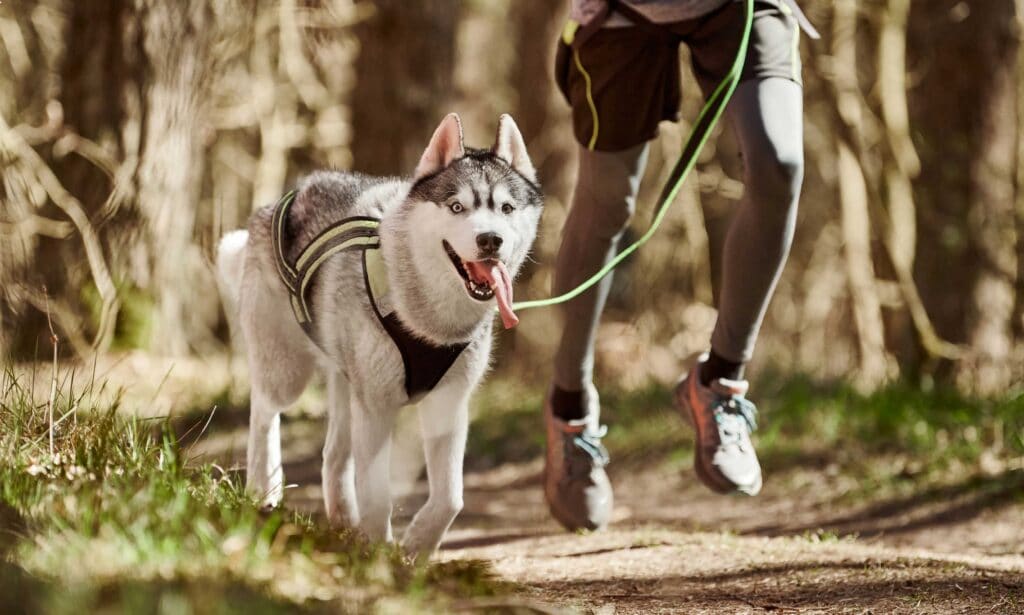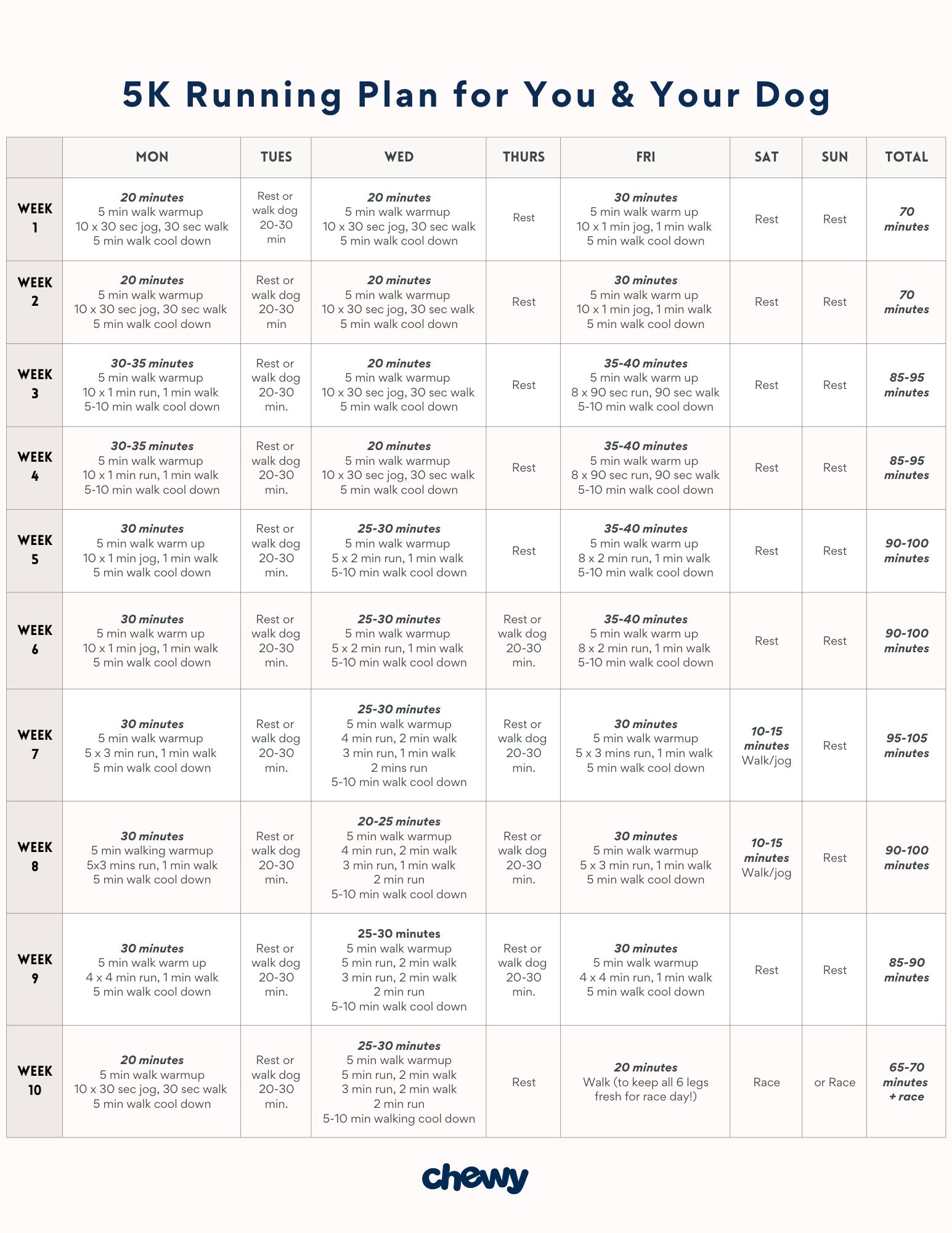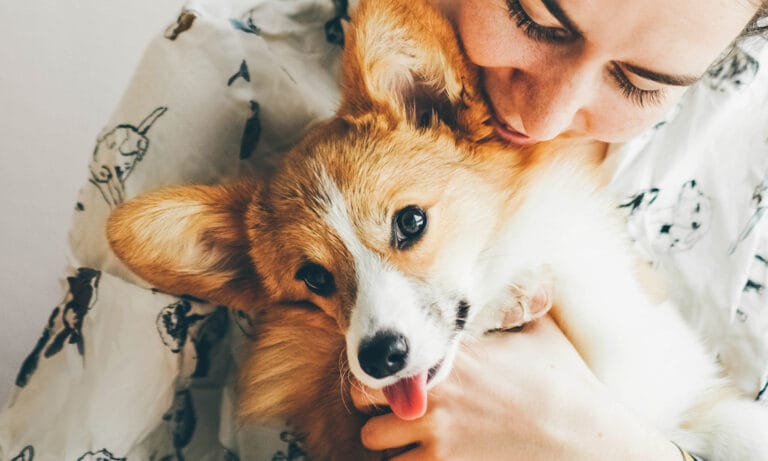If you’ve seen your dog get zoomies, you know the gleeful look on their face when they have the freedom to run. It’s not unlike the rush us humans can experience the first time we catch that elusive “runner’s high.” So it begs the question: Why not combine these experiences and start running with your dog?
There are lots of benefits to picking up a running routine with your dog, but simply lacing and leashing up to hit the pavement without a plan is a recipe for problems—at worst an injury, at best frustration.
Luckily, no matter if you or your dog (or both!) are new to running, with a little forethought and the necessary vet approval, you can be running together in no time. Here, running pros and doggy fitness experts share the steps to create a healthy, lasting running routine—and maybe even run a 5K—with your dog in as little as several weeks.
In This Guide:
The Benefits of Running with Your Dog
They include:
- Bonding: “You're spending time with your dog, getting them out of the house into the environment with smells, things to look at, fresh air,” says Kelly Daniel, FFCP, a certified canine fitness trainer and owner of Hybrid Dog Training in Waikato, New Zealand.
- Improved fitness and health: “[You're] making them lean and stronger, which is great for their joints and long-term health,” Daniel says.
- Physical and mental stimulation: More exercise for your dog also helps limit the potential for behavioral issues at home, as it offers much-needed physical and mental stimulation.
- Building trust: Working as a team helps build trust, says Maria Christina Schultz, a certified canine fitness trainer in Virginia.
And let’s not forget the health benefits for you, the human runner. They include:
- Building aerobic endurance and muscular strength
- Improving your mood
- Offering mental clarity
As for the benefit of running with your dog? Not only is it a great way to bond with them, but your dog also makes for an enthusiastic running partner who helps keep you accountable, says Marnie Kunz, USATF- and RRCA-certified running coach and founder of Runstreet.
“When I run regularly with my dog, she starts getting ready and practically pushes me out the door when it's time to run—talk about accountability!” Kunz says of her 7-year-old rescued Akita named Kiyoshi. “Dogs make life more fun, and each run becomes an adventure when you're together.”
How to Know If Your Dog Is a Good Candidate for Running
1Check with your vet.
Just as you’d get your doctor’s OK to start a new workout routine, your dog will need to get checked out by a veterinary professional before they start running.
"Physical clearance in terms of the dog's weight, structure and orthopedic status of joints is really important," says Daniel.
It's best for a dog to be lean when they start running, and Daniel advises against using running as a tool for doggy weight loss, as added weight can put more force on a dog’s joints.
2Keep your dog’s breed, age, behavior and physical limitations in mind.
Certain dogs just aren't meant to run, including:
- Bulldogs, pugs and other short-nosed dog breeds who will have difficulty breathing
- Great Danes, Newfoundlands and similar extra large dog breeds may not be suited, as well as Basset Hounds or other dogs who have short legs relative to their size, length and weight are more susceptible to joint issues due to their size
- Puppies or young dogs who have not finished growing, as unclosed growth plates are soft and injury-prone, which can cause long-term damage
- Any dog with preexisting orthopedic issues such as luxating patellas or elbow dysplasia, or older dogs with arthritis
- Reactive or severely anxious dogs who could exhibit potentially dangerous behavioral issues on a run
Again, your vet can let you know if your dog is clear to run with you.
3Check in with your dog.
Another necessary buy-in you can’t forego? Your dog’s.
“Not all dogs are meant to run, and not all dogs like the thought of being tied to their owners and forced to run long distances,” says Schultz.
And remember: Just because they seem to want to run with you today, doesn’t mean they’ll always be in the mood to run tomorrow—training schedules be damned.
Daniel recommending building a "we're running" routine that includes a behavior that you can use to gauge your dog actually wanting to run. For example, you could teach your dog to put their head through a harness and cue, "Want to go for a run?"
"This is building consent into your routine," Daniel says.
Must-Have Gear to Effectively Run with Your Dog

It can’t be overstated how the proper gear, such as the right running shoes, can make or break your success on a run.
Once you outfit yourself, stock up on the necessary gear for your pet, too.
Below is your shortlist of dog must-haves for a safe and enjoyable run.
- Harness: Well-fitted, non-restrictive harness that doesn’t dangle to avoid tangles or falls
- Bungee or running belt leash: Allows you to run hands-free while still keeping your dog secure
- Collapsible bowl and water bottle: For hydration stops along the way
- Treats: To refuel as your runs get longer, or in the beginning if your dog needs a little encouragement
- Poop bags: Because you never want to be “that person”
- ID tag: It should be on them at all times, but is especially important when trying new activities outdoors
- Booties: Optional but can help protect your dog’s paws from hard or rough surfaces
- Cell phone: So you can make a call in case of an emergency (it’s also something you should have on solo runs)
- Small running bag or backpack: To carry some of the above, as well as first aid essentials such as bandages and antiseptic (especially if running in a more rural or wooded area)
Tips and Tricks
Ditch the Headphones
Leave the headphones at home when running with your dog.
“Awareness is more important when running with your dog,” Schultz says. “You need to be aware of people and other dogs or wildlife around you at all times, so you can keep yourself and your dog safe.”
You’ll also want to hear vocalizations from your dog if they are in distress.
Bottom line: The playlist you perfected is going to have to wait for your solo runs.
Here's some gear we like:
How to Run with Your Dog
Step 1Get your vet’s OK.
As mentioned, getting prior approval from your vet before you start running is essential—and could save you lots of time, money and heartache in the future.
Your vet can confirm if your young dog’s growth plates have closed, determine if there are existing or previous injuries that would affect their risk, evaluate their joints and assess their overall health.
Step 2Practice your cues for safe running.
Now is a great time to brush up on key dog-training cues—or maybe consult a dog trainer—that will make runs easier.
In addition to good leash skills with walking, handy cues for running include “left” or “right” for turning,” “slow down” and “wait.”
Cues that tell a dog to run at your side, and not leap off a curb after waiting for traffic, are also handy.
“Running with a dog who lunges and barks isn’t fun for the dog, the runner or people who pass you,” says Schultz.
Tips and Tricks
Practice Running with All Your Gear On
This is a good chance for you two to practice running with the appropriate gear—whether that’s a specific hands-free dog leash, bungee leash or running backpack.
“And if you’re planning to run on nothing but pavement or concrete, booties can help protect your dog’s feet,” says Daniel. “So, it’s a good idea to practice getting these on and off, and walking in them, before you start running.”
Step 3Start with low mileage and a slow pace.
Any new runner—two-legged or four—should start with low mileage and a slow pace and never skip the warm-up.
“People tend to injure themselves when they first start out because they go too much, too fast, too soon,” says Alissa Kolarik, RRCA Level 1 running coach, CrossFit Level 1 coach and coach for Lift Run Perform. “Go easier and slower than you think you should. You should be able to think that you could continue running at that pace for a while, even if it's barely faster than a walk. Slow and steady truly wins the race.”
As for your pup, Daniel recommends starting your joint runs at a distance that’s less than your dog’s average walk and very slowly building up.
Try intervals:
- Run/trot for half a mile
- Walk and sniff for a few minutes
- Run/trot for another half mile
Step 4Observe your dog’s behavior—and make adjustments as needed.
Even if you and your pup are both beginner runners, one of you may progress faster than the other.
If your endurance is improving but your pup is lagging behind, consider running short distances together until your dog can keep up.
“Keeping expectations reasonable is very important,” says Schultz. “You have to change your focus when you run with your dog—it’s about being a team. If you’re getting into running because it’s something you want to do with your dog, then run your dog’s run. This will build trust and bonding.”
But don’t forget to be patient with yourself, too. “Even pro athletes have hard days or times when their runs feel off,” says Kunz.
If you're struggling, try Kolarik’s tip: "Try to get to the next pole, the next tree or the next fire hydrant. Doing one more 'rep' shows you that you’re capable of more than you could ever imagine."
Tips and Tricks
Hydrate, Hydrate, Hydrate!
Always include a water break in every run—and keep an eye on your dog for signs of excessive fatigue or overheating.
These may include:
- A change in your dog's running form (which is more like trotting pace), such as if they are constantly wanting to sit down
- If their tongue is swollen or hanging out of their mouth
- Excessive panting or drooling
“Dogs may want to push through pain to make us happy, so we need to be their best advocates,” says Schultz.
Step 5Incrementally increase your training.
The rule of thumb is to increase your running distance or time by no more than 10 percent every week.
“Both humans and dogs need to build their endurance gradually, so training together is a great way to do it,” says Kunz.
This means building in rest days that give your and your dog’s muscles time to recover. Take two to three days off per week. And if you’re a new runner, plan to run every other day.
“Rest days are when you grow and improve,” adds Kolarik. “Taking time for both you and your dog to recover will allow you to make the most strides in your training.”
Your Crate and Couch to 5K Training Plan
More ways to stay active with your dog:
Share:
















